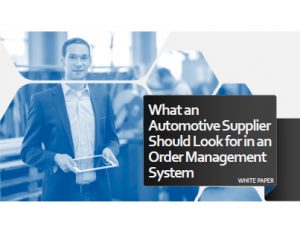What to Look for in an Automotive Order Management System
In the fast-paced automotive industry, having the right tools to manage orders is essential. An automotive order management system ensures suppliers can efficiently respond to customer requirements, coordinate orders, and meet strict compliance standards. The best systems are full-featured, user-friendly, and consistently updated with real-time data from OEM customers.
At the heart of an effective automotive order management system lies a well-integrated electronic data interchange (EDI) solution. This technology enables seamless communication between suppliers, OEMs, and Tier customers, ensuring accuracy, faster processing, and cost savings throughout the supply chain.
Critical Features of an Automotive Order Management System
Critical Order Management System Features
A top-tier automotive order management system incorporates features that streamline operations and meet industry-specific demands. Here are the key capabilities you should look for:
Seamless EDI Integration
- Handle multiple order types in a centralized system, simplifying order management.
- Support various EDI standards, including X.12, UN/EDIFACT, Odette, VDA, and flat file, to meet diverse customer requirements.
- Automate customer updates, such as changing EDI standards or label formats, to reduce manual rekeying and errors.
- Track customer-specific details like kanbans, Release Authorization Numbers (RAN), ship order numbers, dock codes, and pack information.
Cumulative Accounting and Net Requirements Management
- Automate calculations for cumulative (CUM) accounting, including:
- Prior CUM required: The cumulative amount required before new release schedules.
- Supplier CUM shipped: The total amount shipped during a specified period.
- Customer CUM received: The total amount received by the customer over time.
- Coordinate supplier and customer CUM accounting to calculate net requirements due accurately.
Alerts and Notifications
- Set automated alerts for critical changes, such as:
- EDI release net changes
- Price updates
- EDI-to-orders update exceptions
- Notify stakeholders immediately, ensuring swift responses to evolving customer needs.
Integrated ERP Functionality
- Synchronize EDI with ERP order systems, eliminating the need for manual data entry.
- Offer full traceability from inbound EDI to outbound transactions, improving transparency.
Enhanced Shipping and Labeling
- Manage shipping with features like:
- Transit day tracking and late pick-up coordination.
- Support for standard pack logic and international shipments.
- Bar code label format definitions at the destination and order level.
- Toyota Shipping Confirmation System (TSCS) integration
- Track returnable containers and handle freight management for streamlined logistics.
Non-EDI Orders
- Handle non-EDI orders efficiently, ensuring consistency across all transactions.
- Provide flexibility to adapt to unique customer requirements.
Comprehensive Reporting and Utilities
- Monitor selling price changes with detailed reports.
- Track parts in the Pre-Production Part Approval Process (PPAP) to ensure quality compliance.
- Generate robust reports that provide visibility into all stages of the order process.
Gain greater insight and full details about world-class order management in our white paper: What an Automotive Supplier Should Look for in an Order Management System.
Benefits of an Automotive Order Management System
A well-designed automotive order management system offers significant advantages, transforming how suppliers handle orders and meet customer expectations.
Improved Responsiveness
By automating key processes, suppliers can quickly adapt to customer requirements. Real-time data ensures compliance with deadlines and streamlines decision-making.
Enhanced Visibility and Traceability
With integrated reporting and full traceability, suppliers can monitor every stage of the order process. This visibility helps identify bottlenecks and ensures compliance with OEM standards.
Reduced Administrative Costs
An automated system minimizes manual processes, reducing administrative overhead. Functions like shipping, labeling, and order tracking become faster and more efficient.
Increased Customer Satisfaction
A reliable system allows suppliers to respond flexibly to customer needs. Timely and accurate order processing builds trust, reduces errors, and creates a positive customer experience.
Why Your Business Needs a Modern Automotive Order Management System
Investing in a modern, automated automotive order management system ensures your business stays competitive in the demanding automotive industry. With robust EDI integration, seamless ERP synchronization, and powerful shipping features, such a system reduces risks, saves time, and enhances customer relationships.
Are you ready to optimize your order management processes? Explore our white paper, “What an Automotive Supplier Should Look for in an Order Management System”, for a deeper dive into world-class order management.
Let’s talk about how AIM Vision ERP can help you streamline your automotive order management today!




